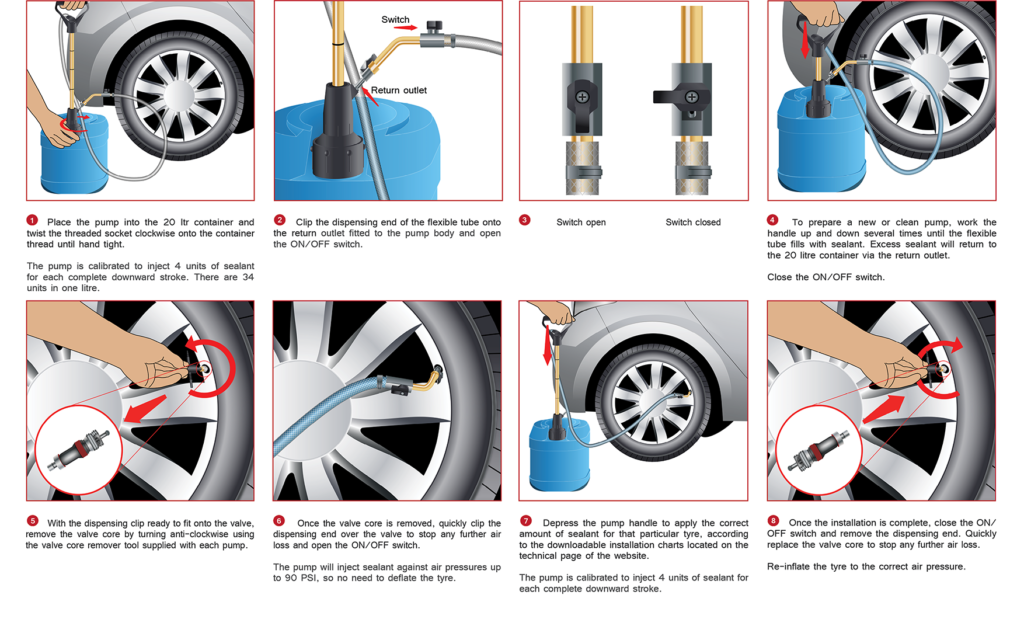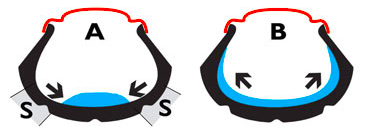How PunctureSafe Works
Once PunctureSafe has been installed, it lies dormant at the bottom of the tyre until the vehicle is first driven. Once driven a minimum of three to five miles, PunctureSafe disperses throughout the inner tyre and forms a coating on the inner surface of the tyre assembly. In order to get sidewall coverage it takes 1500+ miles to activate the FlexxaGel to adhere to more of the inner tyre. The flexing of the tyre and the normal heat build-up allows PunctureSafe to seek out and eliminate common air loss problems (referred to as porosity, air migration and bead leaks).
Puncturesafe then transforms the tyre assembly into a sealed air chamber, capable of maintaining proper air pressure. Thereafter, PunctureSafe conditions the rubber in order to retard dry rot and aging (hardening) of the casing. One treatment will provide additional longevity and cooler running tyres for the legal tread life of the tyre.
The advanced technological sealing capabilities of PunctureSafe stand on guard to seal punctures as they happen. When a tyre is punctured, PunctureSafe coats the surface of the penetrating object, thus preventing air loss.
When the puncturing object is removed, the rubber recovers and the wound immediately closes, escaping air siphons PunctureSafe into the puncture. The fibres entwine to create a clot that prevents any additional air from escaping. As the rubber recovers, the puncture closes and the strength of the tyre holds the seal in place.
The specialised polymers and fibres form the seal, thereby producing an airtight seal. The small amount of PunctureSafe that penetrates through the puncture, past the belts and out through the tread area is referred to as a seal. Once exposed to the atmosphere, the seal begins a systematic cure (another proprietary attribute from the PunctureSafe R&D Team). As the seal cures, it makes a positive secure seal that is impervious to water, which totally protects the belts and inner casing from outside contaminants and corrosion.
PunctureSafe’s proprietary formulation is one of our closely guarded secrets, which allows PunctureSafe to withstand heat and the shear forces created within a rotating tyre. The thixotropic polymers stretches and recovers under mild to severe exposure of the adverse forces and continuously clings to the inner tyre. The ability to coat the inner surface against adverse conditions and centrifugal force is the reason that PunctureSafe will not adversely affect a balanced tyre assembly and does not lose the ability to provide protection for the tread life of the tyre.
PunctureSafe’s abilities & performance is not diminished with speed, distance or time.
Sealing capabilities
If the tyre’s integrity is weakened to a point where the tyre and casing are unsafe, PunctureSafe is designed to bleed and slowly release air pressure in a controlled way if the puncturing object has severely damaged the inner structure.
PunctureSafe will not hide or mask a dangerous puncture regardless of how small the damage may be. If the integrity of the casing has been breached and safety becomes an issue PunctureSafe is designed to allow air to escape in a controlled manner.
Coating and conditioning
PunctureSafe coats and clings to the inner tyre conditioning the inner surface, eliminating air migration caused by porosity and bead leaks.
It is imperative that the proper amount of PunctureSafe be installed in a tyre (refer to application chart). In order for PunctureSafe to function, the vehicle should be driven approximately 3 to 5 miles (it is not required to immediately drive the vehicle). This initial driving allows the tyre to warm up and for PunctureSafe to distribute. Puncturesafe will cover the crown area in the first few miles but it will take another 1500+ miles for the FlexxaGel to activate giving more coverage of the sidewall. Unlike conventional tyre sealants, PunctureSafe has been developed to prevent migration from the sidewalls and the tread area at high speeds. Once the initial driving/usage period has been attained; Puncturesafe cover more of the inner surface of the tyre.
PunctureSafe is a proprietary liquid coating that never deteriorates within the tyre and will continuously stand on guard to protect tyres against air loss for the legal tread life of the tyre.
Will not cure or harden inside the tyre
People often ask, “If PunctureSafe cures from exposure to outside air, then why doesn’t it cure by the air inside of the tyre?” PunctureSafe transforms the tyre and rim into a sealed air chamber. As the vehicle is driven and the temperature of the tyre increases, a portion of the liquid base vaporises within the tyre assembly’s inner air cavity, as the tyre cools, the moisture condensates back into the formula. The inside air actually becomes part of the system. The sealed air chamber prevents outside air from entering or inside air from escaping. Constant air pressure maintenance is not required.
Positive secure seal
When a tyre is punctured, PunctureSafe is forced against and around the puncturing object by the inner air pressure, thereby preventing air from escaping. If the puncturing object is thrown out of the tyre by centrifugal force or is pulled out, the inside air forces PunctureSafe into the puncture and immediately stops air loss. Special fibres entwine, forming a seal, then as the rubber recovers, aided by the tyre flexing as it rotates, the inner air pressure forces the seal well into and through the puncture. Once PunctureSafe is exposed to the outside air, a curing process begins. The cured seal extends well into the puncture, thus providing a seal that is impervious to water (rain, snow, mud, etc.). As this seal cures, it is transposed into a permanent rubberised seal, protecting the inner casing and steel belts against contaminants entering the puncture.
The 80/20 syndrome
The seal is permanent because of two very important attributes of PunctureSafe:-
A/…there is no shrinkage of the drying polymer in the puncture because the gel is 80% polymer and only 20% liquid because we do not use cheap ingredients that bind huge amounts of water. It is common for similar products to be the other way round with 20% polymer and 80% liquid.
B/…The gel dries and cures to a firm, flexible and rubber consistency which means the seal will flex with the puncture causing no air loss over time.
It is a fact that any viscous wet compound containing fillers such as fibres and rubber particles will initially seal a puncture whilst in the wet state because wet compounds will flex with the tyre in the puncture, but the problems arise in many of these “so called” similar products when the liquid escapes out of the puncture into the atmosphere causing the compound in the puncture to dry back to the original ingredients. When dried out these “so called” similar products will vary in looks and texture because of the vast difference with ingredients used in these tyre sealants to such as:- Biscuit, Plasticine, Putty, Paper, Crystalline, Flour, Sticky pritstick, Bluetack, cement, clay etc.
The descriptions and looks of many of these dried out products are neverending, but it is a fact that in the wet state these gloopy tyre sealants all look very similar, except in colour, but that is where the similarity ends. Many of these compounds that have usually been formulated by people without any knowledge of chemistry whatsoever, once dried out in the puncture will eventually fail, resulting in a flat tyre, sometimes within days or just weeks after the initial puncture.
The eight images directly below are of PunctureSafe and six “so called” similar products that have been allowed to dry out in a laboratory oven at 50 degrees C for 24 hours. When fully dry PunctureSafe has very little shrinkage and is flexible and firm which is the attributes required of a dried out tyre sealant in the puncture to permanently seal the puncture, and especially in the low speed market were punctures can be caused by puncturing objects up to 30 mm in diameter. It is our trademarked secret ingredient “FlexxaGel™” that gives PunctureSafe so many of its quality attributes.

PunctureSafe Does Not Cause a Balance Problem?
The law of physics are quite precise, especially when it comes to liquids in a centrifuge, they will be forced in the direction of the forces, which in a moving tyre is in the opposite direction from the wheel rim. A tyre on a moving vehicle is a centrifuge and tyre sealants inside a tyre will obey these laws and be forced outwards to the highest point which is the centre of the crown area as shown in diagram A below.
As a vehicle gathers speed, tyre sealants form a narrow band in the centre of the crown area of the tyre and the width of this band is dependant on the vehicles speed. At only 2 miles per hour that band will be narrow covering approximately only 70% of the crown area, but as the vehicles speed increases to normal driving speeds of 20 to 60 mph that band narrows significantly as the centrifugal forces increase. With these higher speeds a tyre sealant will begin to pile up in a bulky mass as extreme forces come into effect as shown by the arrows in diagram A.
At these high speeds and with these conditions balance problems are prevalent. Sideways movement of the vehicle will temporarily cause a little sealant to creep across the shoulder area, but forward movement will immediately bring it back again. Also because of the low crown coverage, even at speeds of only 2 mph, there is no protection against punctures in the shoulder region of the tyre as shown in the grey shaded area marked S in diagram A.
PunctureSafe covers more of the the inner tyre “at all speeds”, yes from 2 kph to 250 kph – better coverage, as shown in diagram B below and that gets better the more miles the vehicle covers. As the vehicles speed increases, PunctureSafe’s thixotropic polymer gel stretches over the inner tyre giving good coverage with a very thin layer no thicker than 2 or 3mm, and that is the reason balance problems do not occur with PunctureSafe.
(The PunctureSafe gel will relax in a stationary vehicle covering less of the inner tyre) We at PunctureSafe UK have managed to achieve this in a process using very advanced chemistry not normally found in any other tyre sealant. Our proprietary process which gives PunctureSafe these attributes and other beneficial properties is our most closely guarded secret which no other manufacturer has yet managed to duplicate. You need very sophisticated equipment to achieve this level of chemistry which we have had built entirely to our specification.
Large rubber particles of 1 mm in size normally found in tyre sealants are also a big cause of balance problems. We granulate our own rubber particles right down to between .2mm and .4mm for inclusion in our high speed grades .

Manufactured with FlexxaGelTM our mostclosely guarded trade secret
When a puncture occurs, the centrifugal forces of the rotating tyre, plus internal pressure and escaping air, forces the gel into the puncture and a permanent seal is created.
– A Permanent Seal
– Extends Tyre Life
– Reduced Downtime
– Improved Fuel Economy
– 100% Non-Toxic, 95% Organic
You can find us at
555 George Street, Aberdeen, AD25 3XX
Opening Hours
Monday – Saturday
(10AM – 6PM)
Call us Now
+447974312916 (Fred)
+447723328501 (Bim)
Support
info@harmonieventures.com
Copyright (c) harmonieventures 2021. Powered by iBrowseo
